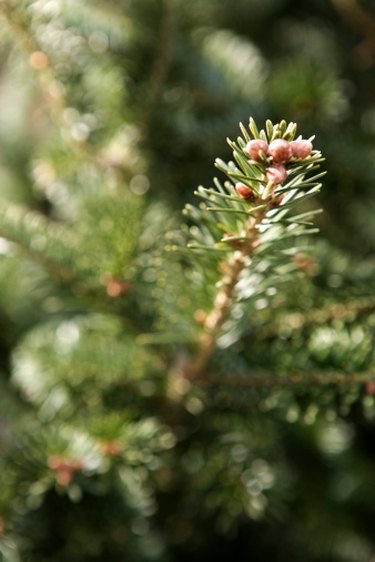
Fir trees – nine types grow wild in North America – belong to the genus Abies, while the four North American hemlock species are part of the Tsuga genus. Firs and hemlocks differ in size, foliage and preferred growing conditions; both come in parent form and multiple cultivars suitable for landscaping tasks. Both trees serve a variety of functions, such as specimen trees, hedges, windbreaks and privacy screens.
Size
Video of the Day
Of the hemlocks, only western hemlock (Tsuga heterophylla) challenges the mature height of the majority of fir trees. Mountain hemlock grows between 125 and 175 feet in the Pacific Northwest, while the rest of the hemlocks are in the 50- to 100-foot range. Many fir species, such as white fir (Abies concolor) and noble fir (Abies procera), commonly grow between 100 and 150 feet tall.
Video of the Day
Needles
The evergreen foliage of fir trees differs from that of hemlocks. Hemlocks feature a narrow, flat, evergreen needle that tapers at its base to form a tiny stem, attaching to the twigs on what resembles a woody cushion. The needles on a fir tree appear plump or flat in a cross-section view. They grow right out of the twigs and leave a depression in the twig when you remove them. Fir needles usually are longer than those found on hemlocks. Hemlock needles normally do not exceed an inch in length, while the needles on firs, like the white fir, develop to 3 inches in length.
Cones
Fir tree cones come in a wide array of sizes. Those of the California red fir (Abies magnifica) may grow to as long as 9 inches, while some firs – including balsam fir (Abies balsamea) – produce a cone as small as 2 inches long. Hemlock cones are small, with only the mountain hemlock generating a cone as long as 3 inches. Canadian hemlock (Tsuga canadensis) has a cone that is less than an inch long.
Growing Conditions and Geography
Hemlocks adapt to shady sites more readily than do the fir trees. Firs thrive in a full-sun location while the hemlocks do well in cool, damp environment without the benefit of constant sunshine. Geographically, most of the firs grow in the western portion of North America, with only the balsam fir and the Fraser fir (Abies fraseri) native to eastern regions. Canadian hemlock and Carolina hemlock (Tsuga caroliniana) grow in the East, while mountain hemlock (Tsuga mertensiana) and western hemlock exist in the Northwest.